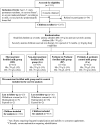Micronutrient fortified milk improves iron status, anemia and growth among children 1-4 years: a double masked, randomized, controlled trial
- PMID: 20730057
- PMCID: PMC2921413
- DOI: 10.1371/journal.pone.0012167
Micronutrient fortified milk improves iron status, anemia and growth among children 1-4 years: a double masked, randomized, controlled trial
Abstract
Background: Multiple micronutrient deficiencies are highly prevalent among preschool children and often lead to anemia and growth faltering. Given the limited success of supplementation and health education programs, fortification of foods could be a viable and sustainable option. We report results from a community based double-masked, randomized trial among children 1-4 years evaluating the effects of micronutrients (especially of zinc and iron) delivered through fortified milk on growth, anemia and iron status markers as part of a four group study design, running two studies simultaneously.
Methods and findings: Enrolled children (n = 633) were randomly allocated to receive either micronutrients fortified milk (MN = 316) or control milk (Co = 317). Intervention of MN milk provided additional 7.8 mg zinc, 9.6 mg iron, 4.2 microg selenium, 0.27 mg copper, 156 microg vitamin A, 40.2 mg vitamin C, and 7.5 mg vitamin E per day (three serves) for one year. Anthropometry was recorded at baseline, mid- and end-study. Hematological parameters were estimated at baseline and end-study. Both groups were comparable at baseline. Compliance was over 85% and did not vary between groups. Compared to children consuming Co milk, children consuming MN milk showed significant improvement in weight gain (difference of mean: 0.21 kg/year; 95% confidence interval [CI] 0.12 to 0.31, p<0.001) and height gain (difference of mean: 0.51 cm/year; 95% CI 0.27 to 0.75, p<0.001). Mean hemoglobin (Hb) (difference of 13.6 g/L; 95% CI 11.1 to 16.0, p<0.001) and serum ferritin levels (difference of 7.9 microg/L; 95% CI 5.4 to 10.5, p<0.001) also improved. Children in MN group had 88% (odds ratio = 0.12, 95% CI 0.08 to 0.20, p<0.001) lower risk of iron deficiency anemia.
Conclusions/significance: Milk provides an acceptable and effective vehicle for delivery of specific micronutrients, especially zinc and iron. Micronutrient bundle improved growth and iron status and reduced anemia in children 1-4 years old.
Trial registration: ClinicalTrials.gov NCT00255385.
Conflict of interest statement
Figures
References
-
- Lopez AD, Mathers CD, Ezzati M, Jamison DT, Murray CJ. Global and regional burden of disease and risk factors, 2001: systematic analysis of population health data. Lancet. 2006;367:1747–1757. - PubMed
-
- Black RE, Allen LH, Bhutta ZA, Caulfield LE, de Onis M, et al. Maternal and child undernutrition: global and regional exposures and health consequences. Lancet. 2008;371(9608):243–260. - PubMed
-
- Shrimpton R, Victora CG, de Onis M, Lima RC, Blössner M, et al. The worldwide timing of growth faltering: Implications for nutritional interventions. Pediatrics. 2001;107:E75. - PubMed
-
- Rivera JA, Hotz C, Gonzalez-Cossio T, Neufeld L, Garcia-Guerra A. The effect of micronutrient deficiencies on child growth: a review of results from community-based supplementation trials. J Nutr. 2003;133:4010S–4020S. - PubMed
-
- Ramakrishnan U. Prevalence of micronutrient malnutrition worldwide. Nutr Rev. 2002;60:S46–S52. - PubMed
Publication types
MeSH terms
Substances
Associated data
LinkOut - more resources
Full Text Sources
Medical


